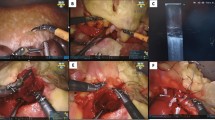Abstract
Purpose
Non-animal simulation models can allow trainees to practice the key steps and skills required for laparoscopic procedures outside the tightly controlled setting of specific simulation labs and courses. Here, we set out to describe and disseminate how one can build a laparoscopic ureteric reimplantation and pyeloplasty model at home for training, using simple materials and evaluate its value for training.
Methods
We have developed two plastic- and silicone-based models for simulating laparoscopic pyeloplasty, and used it for training at the BAPES Scholarship Advanced Minimal Access Surgery Urology Course. We received both quantitative and qualitative feedbacks from both trainers and trainees.
Results
When rating the course 1–5 (1 not useful, 5 useful), candidates gave median scores of 4 for the simulation usefulness, transferability of skills, and realism. With the reimplantation model, candidate scores for all three areas improved familiarity (mean 3.2–4.8, P < 001), confidence (1.9–3.3, P < 0.001), and competence (1.8–3.8, P < 0.001). With the laparoscopic pyeloplasty model; confidence (3.2–4.2, P < 0.001) and competence (3.4–4.1, P < 0.001) increased. Qualitative data from candidates and trainers were positive, specifically when rating the models' realism and its use for teaching the surgical steps.
Conclusion
Low-fidelity models have a key role for surgical training. Establishing key surgical steps and through being more easily accessible for trainees, they offer a valid and useful alternative to high-fidelity simulation.


Similar content being viewed by others
References
Persin J, Evans GRD (2007) Soft-tissue surgery of the craniofacial region. CRC Press, Boca Raton
Kneebone R, Aggarwal R (2009) Surgical training using simulation. BMJ 338:b1001
Windsor JA (2009) Role of simulation in surgical education and training. ANZ J Surg 79:127–132
Mason DG, Shotton H, Wilkinson KA et al (2012) Children's surgery: a national survey of consultant clinical practice. BMJ Open 2:e001639. https://doi.org/10.1136/bmjopen-2012-001639
Ilgen JS, Sherbino J, Cook DA (2013) Technology-enhanced simulation in emergency medicine: a systematic review and meta-analysis. Acad Emerg Med 20(2):117–127
Tan SS, Sarker SK (2011) Simulation in surgery: a review. Scott Med J 56(2):104–109. https://doi.org/10.1258/smj.2011.011098
Millán C, Rey M (2019) LAParoscopic simulator for pediatric ureteral reimplantation (LAP-SPUR) following the Lich-Gregoir technique. J Pediatr Urol 14:137–143
Hubertus R, Gerharz WE (2008) Antireflux surgery: Lich-Gregoir extravesical ureteric tunnelling. BJU Int 101(11):1467–1482
Hamstra S, Brydges R, Hatala R (2014) Reconsidering fidelity in simulation-based training. Acad Med 89(3):387–392
Matsumoto ED, Hamstra SJ, Radomski SB, Cusimano MD (2002) The effect of bench model fidelity on endourological skills: a randomized controlled study. J Urol 167(3):1243–1247
Kolb D (1984) Experiential learning: experience as the source of learning and development, vol 1
Karpicke JD, Roediger HL (2007) Repeated retrieval during learning is the key to long-term retention. J Mem Lang 57(2):151–162
Author information
Authors and Affiliations
Corresponding author
Rights and permissions
About this article
Cite this article
Thompson, D.S., Paget, R. & Cherian, A. The role of low-fidelity simulation in paediatric endoscopic training: Build your own. J Ped Endosc Surg 1, 155–159 (2019). https://doi.org/10.1007/s42804-020-00044-y
Received:
Revised:
Accepted:
Published:
Issue Date:
DOI: https://doi.org/10.1007/s42804-020-00044-y




